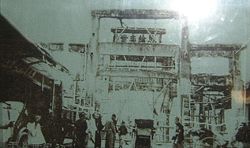
Hangzhou City Walls
Encyclopedia


Hangzhou
Hangzhou , formerly transliterated as Hangchow, is the capital and largest city of Zhejiang Province in Eastern China. Governed as a sub-provincial city, and as of 2010, its entire administrative division or prefecture had a registered population of 8.7 million people...
area can be traced back 5000 years to the Neolithic
Neolithic
The Neolithic Age, Era, or Period, or New Stone Age, was a period in the development of human technology, beginning about 9500 BC in some parts of the Middle East, and later in other parts of the world. It is traditionally considered as the last part of the Stone Age...
jade-carving Liangzhu Culture
Liangzhu culture
The Liangzhu culture was the last Neolithic jade culture in the Yangtze River Delta of China. Its area of influence extended from around Lake Tai north to Nanjing and the Chang Jiang, east to Shanghai and the sea, and south to Hangzhou...
. The Liangzhu culture built earthen walls that served two purposes, to protect their settlements from invaders and to serve as dikes to prevent flooding. Over the subsequent course of Chinese history, Hangzhou changed hands many times, and every ruler and every dynasty had its own contributions and modifications to the Hangzhou City Walls. While little remains of them today, the fact that Hangzhou was once a walled city is still evidenced by certain place names around town, especially the names of its ten gatehouses.
Sui Period
Hanghzou's first city walls were built during the Sui PeriodSui Dynasty
The Sui Dynasty was a powerful, but short-lived Imperial Chinese dynasty. Preceded by the Southern and Northern Dynasties, it ended nearly four centuries of division between rival regimes. It was followed by the Tang Dynasty....
in the 11th year of Sui Kaihuang
Emperor Wen of Sui
Emperor Wen of Sui — personal name Yang Jian , Xianbei name Puliuru Jian , nickname Naluoyan — was the founder and first emperor of China's Sui Dynasty . He was a hard-working administrator and a micromanager. As a Buddhist, he encouraged the spread of Buddhism through the state...
, corresponding to 591 AD. Its perimeter is recorded as being 36 li
Li (unit)
The li is a traditional Chinese unit of distance, which has varied considerably over time but now has a standardized length of 500 meters or half a kilometer...
and 90 paces long. Its eastern boundary would have been about where Zhonghe Road (中河路) is today. The western wall ran along the eastern bank of Xihu
West Lake
Xī Hú is a famous fresh water lake located in the historic center of Hangzhou, the capital of Zhejiang province in eastern China. The lake is divided by the causeways of Sū Tí , Bái Tí , and Yánggōng Tí...
, the West Lake. To the south the wall pressed up against Fenghuang Mountain (凤凰山) and its northern limit was the Qiantang Gate (钱塘门), roughly where today's No. 6 Park (六公园) is. Certain parts of modern day Hangzhou's downtown area would not have been included inside the Sui city walls, such as Mt. Wu (吴山) being excluded by an indent in the wall and Wulin Road (武林路) being too far north.

